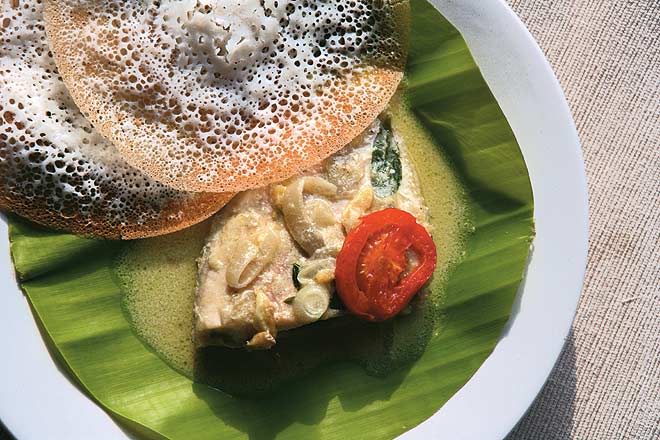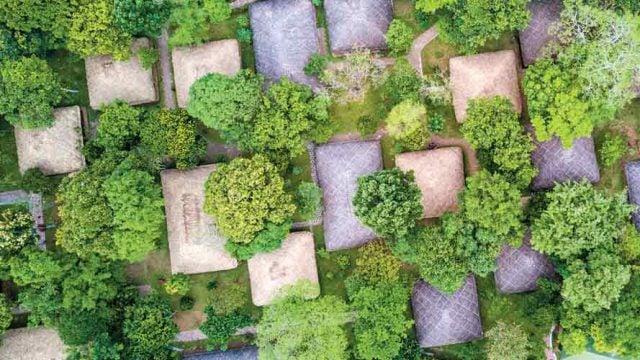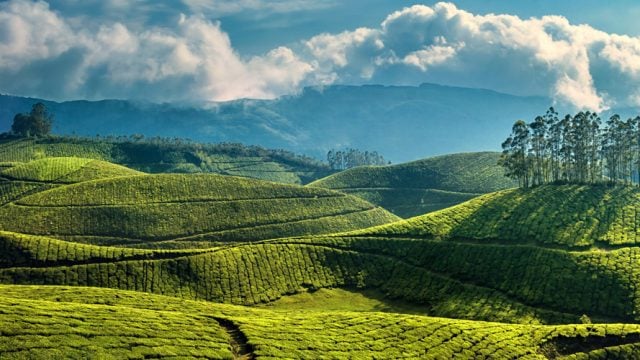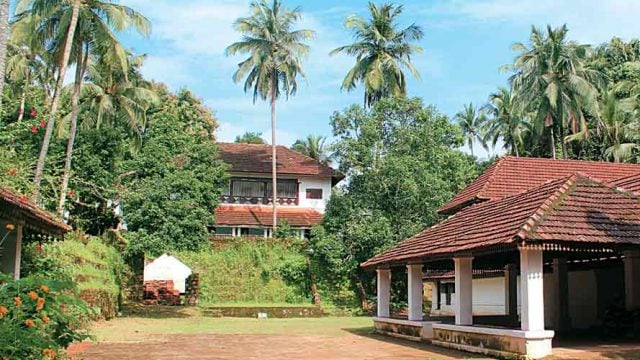I can’t wait to get my teeth into some, says Yash. We are on the 75km cab
I hope there’s lots of it, he adds, and now I get the feeling that he isn’t really talking to me so much as to the great provenancer referred to in damn-fool names such as God’s Own Country. I share his hope, but refrain from comment since I can always get it in Bangalore even if it doesn’t advertise its availability. Instead, I wait till we have left the interminable city that Kochi has imposed on neighbouring towns and then I roll the windows down a wee bit. My pet theory is that my lungs unfurl like flags in Kerala, neither out of any returning-native-son nonsense, nor due to the smell of any peculiar earth though that is abundantly on offer. The air, there, is always laden with the gentlest hints of the good and stringy, because there is always somebody frying many strips of meat from genus Bos with carefully sliced coconut slivers, and my nostrils pick up the most delicate or most distant such whiff, and thus the benefit to bronchial tubes. And so, there I was, pointing my nose at the small gap through which the landscape left some trace of itself as it rushed past us like a thing demented. Of the two possible happy endings, only one was to be. But let us not get ahead of ourselves.
Philipkutty’s Farm sits athwart Puthen-kayal, a manmade island of several hundred acres created within the Vembanad Kayal in the 1950s. Puthenkayal was perhaps the last in a series of efforts at wresting land from the backwaters that began during the days of the Maharajas of Travancore. The farm was once covered with rice paddies, but that was given up in favour of more sustainable crops, such as coconut, and spices such as nutmeg, mace and pepper. As in the rest of the Kuttanad area, crops are grown on land that is below sea level. When the monsoon arrives, it takes hours of pumping rainwater out into the kayal to prevent water logging and losses. I ask about power-failures, and I’m told that several nutmeg trees died after a particularly epic disruption of supply some years ago.
The Vembanad, one of the biggest Ramsar sites in India, stretches across three districts in Kerala and is fed by the Periyar and the Pamba and a bunch of smaller rivers. You will hear the terms lake, backwater and lagoon used interchangeably when people refer to it. I prefer the word kayal — the first vowel is longer — because it says something that the other terms simply don’t convey. My copy of Gundert’s traces the word back to the verb kaayuka — meaning either ‘to boil’ or ‘to dry up’. The range of the verb seems to encompass a wry summary of what life is like for those who live here and a picture of what happens to the water. This etymological sally has me so kicked that I begin forming another neat little theory — this time on the difference in imagination between European geographers, whose terms suggest that they saw land and water as forces to be contained, and unsung local heroes whose names condensed lived experience into acute metaphors. The grand project falls apart in five minutes. I find that the term ‘estuary’ owes its origins to precisely the same metaphor as kayal.
The farm began offering homestays 10 years ago. Vinod Mathew, the son of the man whose name the farm bears, had five villas built along traditional lines — down to solid wooden pillars, little recesses fitted out with seating, tiled floors, sanded courtyards and doors that split into four quarters. These inordinately beautiful buildings sit plumb on the waterfront and allow you to sit on a swing or loll on a ‘sit-out’ and measure your day either by the succession of. (also quaintly known as ‘houseboats’, each one a transposition of a thatched house onto planking to create a rather startling shape) that huff past, or by the number of times the little vallams, or country-boats, do the up-and-down between island and the opposite shore. I learnt to admire the economy of their straight lines following an afternoon spent watching another guest pole his way to the other shore in an extravagant, looping curve after several attempts that seemed to bring him back to our shore.
We arrive and are shown our digs. The ceiling sits far above our head and makes the shape of an upturned boat, an oddly reassuring image. Its dark, polished timbers swallow the harshness of the noonday sun and the room contains the powdery exhaustion of the few sunbeams that have managed to escape. Over a couple of days, we find that this womb away from the sun is a great bringer-on of shut-eye and a silent thrower of switches vis-à-vis the appetite. We also find that retreating too early to these residences is likely to contract our time into an orgy of sloth and gluttony.
Our first meal is a late lunch, rustled up for us in the 15 minutes in which we have been communing with our ceiling. The Lazy Susan rotates at a leisurely pace and offers us red rice, dal, two kinds of thoran — beetroot and beans — the day’s catch, freshly fried, and routine accompaniments such as pappadam and pickle. I’m a bit of a thoran fanatic and I serve myself monster helpings. A good thoran — essentially a stir-fry with coconut and seasoning — occupies a precise location between raw and cooked, between crunch and crisp. Both beans and beetroot simply find the spot today. After many systematic raids, I notice that I’ve been missing what seems like a pachidi. I try it, and I figure that I’ve been rudely ignoring the outstanding element of the meal. Pachidis (literally ‘ground raw’) typically bring together curd, grated coconut and sundry vegetables but this one is a pineapple pachidi. My taste buds fall into swirling confusion: for some reason this renews my appetite and I begin all over again. The dessert is elayappam, a kind of rice-flour pancake stuffed with coconut and jaggery and steamed within a banana-leaf wrap. The jaggery is molten, and it takes all my self-control to keep from yelping in response to being assailed simultaneously by sinful pleasure and small suffering.
We get to talking of the cuisine. Anu Mathew, our co-host, says that in these parts it is fish and vegetables that really matter. Duck is a seasonal delicacy and chicken, she says, is something they make for the guests. I’ve always wondered about the many variations within Nasrani (or Syrian Christian) cuisine and Anu’s answer is that it varies from family to family. There are however definite, if somewhat puzzling, regional variations — pork is okay among some Nasrani communities, while it is anathema among the villages of the south, where my mother comes from. Beef too traverses a similar arc of acceptability. I suspect that there is room here for a good theory — one that allows for some interplay between the availability of particular forms of flesh, caste variations and the troubled interactions between the Portuguese and the Nasranis — to account for these differences. My abysmal luck with theorising over this trip compels me to reluctantly let the opportunity pass.
When Yash understands that the Kerala beef fry he has been fantasising about isn’t going to make an appearance anytime soon, his face falls and dwindles into a memory of underdevelopment, but over three meals I decide that I couldn’t Keral less. Each meal has offered a fresh set of surprises.
After one determined bout of table-emptying (high-points: fish molee and a pineapple-and-coconut-milk dessert), I fall to thinking about the distinctive colour-scheme of Nasrani cuisine. The only dash of extravagance I can find is in the deep red of the fish curry. The palette seems to otherwise favour both restraint and a kind of blending with the landscape: nut brown, earth brown, lily white and green. After another meal, I can’t but help contrast what my beef-eating relatives would see as adequate veggies (achieve the texture of good-quality paper and fuggedaboutit) with the subtle variations of spice and seasoning at Philipkutty’s that turn even cabbage thoran into something worth lingering over. At breakfast one day, there are two different kinds of sambar and my life is immediately reduced into a matter of spoons and swoons. One features drumsticks, and the other is a vendakka (ladyfinger) sambar. After several minutes of silent inward debate, I decide that the drumstick is champ, if only by a single point. It is only later that I realise that I have successfully ignored the dosas that the sambars were meant to accompany. Any regret I could have begun feeling was made unnecessary by the appearance of the closing item — strips of banana rolled around in ghee and fried till they had achieved a kind of caramelised flavour.
My last meal is of mythic proportions: a superbly spiced red fish curry, balancing delicately on the spite of kokum and the fiery kiss of red chillies, beetroot pachidi, red rice, cabbage thoran, lime pickle, banana-flower cutlets and karimeen fry done with artistry because it was done just short of crispness.
Aniamma Philip, our co-host, presides over a lesson in Nasrani cuisine every day, assisted by her daughter-in-law Anu. Guests are encouraged to participate on most days, but on this occasion we have a full house and so the spectators restrict themselves to crushing leaves and spices between their fingers and inhaling deeply. We are taught how to make a fish molee and we follow the ritual of smashing ginger, garlic, onion and green chillies around till they take on a mild glaze with tense attention and many questions. After her grand-daughter contributes three stalks of curry leaves with much clapping of hands, Aniamma makes sure we have registered exactly how much turmeric must go in, followed by the fish, and the necessary spices. She anticipates our questions with a brisk kindness and an admirable economy with words (“any fish can be used” and “now add thin coconut milk — more water, less cream”) and allows the molee to simmer for a while, before topping it with sliced tomatoes. She rolls the contents around gently and gives the phrase ‘shaken, not stirred’ a new life before tossing in vinegar made from toddy. The crucial moment is now upon us — she spoons a little into her hands and tosses it on to her tongue with an explosive ‘twick’. That sound is the signal that today’s effort passes muster. The flame is turned off and the thick coconut milk, which has been skulking in the background, now comes into its own. It can be added only after the molee has been taken off the stove — to do otherwise would result in embarrassing results. We consume the molee 15 minutes later — and the sense that something occult has passed into the realm of the do-able keeps the conversation going for a long time.
I am unable to resist one last stab at theorising. The two definitive qualities of Nasrani cuisine seem to spring naturally from the two worlds that they straddle. One is a sort of thrift with material; they make war on humidity and its consequences and return natural fire with drying and with douses like vinegar. This is perhaps the husbandry that comes naturally to the farmer. The other quality is a genius for adaptation expressed in truly unexpected ways such as the banana-flower cutlet and the pineapples stewed in coconut milk — surely a hallmark of mercantile genius.
Outside of all this, there is the genius of place that settles equitably on everybody who visits. Devassia, the boatman, who came to fetch us after the taxi ride brought his boat in sharply to administer a gentle ramming to the miserable craft that some interloper had tied to their pier. He then smiled in embarrassment at us and said one has to teach these chaps a lesson. We forbore from comment even though we saw nobody learning anything. In the next five minutes, he told us how deep the water was, commented on the lack of other-shore etiquette among taxi-drivers and held forth on how it would take me no more than five minutes to learn how to manoeuvre the boat.
At dawn the next day, Yash and I set out on another boat ride because sunrise sounded like a great thing to chase. What followed was a leisurely little skip across the waters, interrupted now and then by the groans of water hyacinth as we cut across their networks while the mist rose in little wisps from the surface in the middle distance. I bother Tommy, the other boatman, for crocodile stories and he tells me that the last croc seen in these parts was shot dead by a Britisher many, many years ago. When the sun arrives, it’s in a tearing hurry and races across the sky into blaze position in no time at all.
I make the journey back to Kochi in the company of JP, who normally drives guests around. This time around, I have the leisure for conversation since I am neither navigating nor sniffing the air for the telltale fumes of fried beef. The trick is to take the Vaikom-Kumarakom road rather than the highway. And thus I notice the many small towns that adventurous visitors could drive to and explore — Vaikom, for one, which witnessed a famous temple-entry satyagraha in the 1920s, and Tripunithura. Kumarakom is a short hop away, as is the famous barrier across the backwater at Thanneermukkom.
As I leave, one image stays with me. We were offered the obligatory album to look at on arrival, and one image caught Yash’s eye, and began the writing of my piece. The image is stark in its simplicity and features Aniamma, armed with an umbrella, towering over her grandson on an early morning boat ride to school in an attitude that turns even the camera into an interloper, while the rain tears bullet-sized holes out of the water all around them. That photograph seems to say so much about the doughty pair of women who run Philipkutty’s Farm, undaunted by the workings of Fate and the loss of loved ones.
Syrian Christian food
Leave a Reply
You must be logged in to post a comment.





